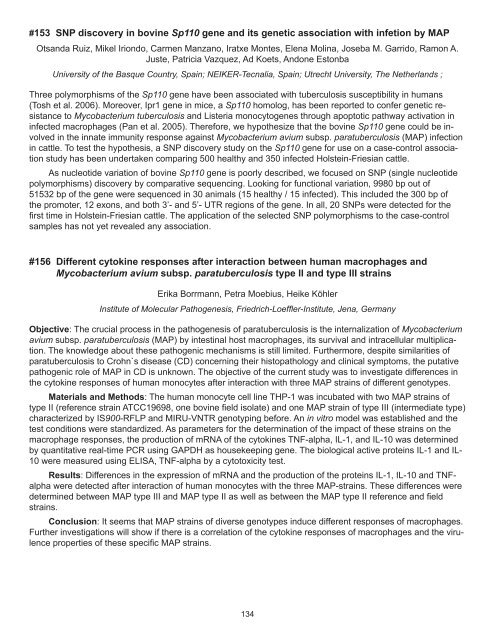Proceedings of the 10th International Colloquium on Paratuberculosis
Proceedings of the 10th International Colloquium on Paratuberculosis
Proceedings of the 10th International Colloquium on Paratuberculosis
You also want an ePaper? Increase the reach of your titles
YUMPU automatically turns print PDFs into web optimized ePapers that Google loves.
#153 SNP discovery in bovine Sp110 gene and its genetic associati<strong>on</strong> with infeti<strong>on</strong> by MAP<br />
Otsanda Ruiz, Mikel Iri<strong>on</strong>do, Carmen Manzano, Iratxe M<strong>on</strong>tes, Elena Molina, Joseba M. Garrido, Ram<strong>on</strong> A.<br />
Juste, Patricia Vazquez, Ad Koets, And<strong>on</strong>e Est<strong>on</strong>ba<br />
University <str<strong>on</strong>g>of</str<strong>on</strong>g> <str<strong>on</strong>g>the</str<strong>on</strong>g> Basque Country, Spain; NEIKER-Tecnalia, Spain; Utrecht University, The Ne<str<strong>on</strong>g>the</str<strong>on</strong>g>rlands ;<br />
Three polymorphisms <str<strong>on</strong>g>of</str<strong>on</strong>g> <str<strong>on</strong>g>the</str<strong>on</strong>g> Sp110 gene have been associated with tuberculosis susceptibility in humans<br />
(Tosh et al. 2006). Moreover, Ipr1 gene in mice, a Sp110 homolog, has been reported to c<strong>on</strong>fer genetic resistance<br />
to Mycobacterium tuberculosis and Listeria m<strong>on</strong>ocytogenes through apoptotic pathway activati<strong>on</strong> in<br />
infected macrophages (Pan et al. 2005). Therefore, we hypo<str<strong>on</strong>g>the</str<strong>on</strong>g>size that <str<strong>on</strong>g>the</str<strong>on</strong>g> bovine Sp110 gene could be involved<br />
in <str<strong>on</strong>g>the</str<strong>on</strong>g> innate immunity resp<strong>on</strong>se against Mycobacterium avium subsp. paratuberculosis (MAP) infecti<strong>on</strong><br />
in cattle. To test <str<strong>on</strong>g>the</str<strong>on</strong>g> hypo<str<strong>on</strong>g>the</str<strong>on</strong>g>sis, a SNP discovery study <strong>on</strong> <str<strong>on</strong>g>the</str<strong>on</strong>g> Sp110 gene for use <strong>on</strong> a case-c<strong>on</strong>trol associati<strong>on</strong><br />
study has been undertaken comparing 500 healthy and 350 infected Holstein-Friesian cattle.<br />
As nucleotide variati<strong>on</strong> <str<strong>on</strong>g>of</str<strong>on</strong>g> bovine Sp110 gene is poorly described, we focused <strong>on</strong> SNP (single nucleotide<br />
polymorphisms) discovery by comparative sequencing. Looking for functi<strong>on</strong>al variati<strong>on</strong>, 9980 bp out <str<strong>on</strong>g>of</str<strong>on</strong>g><br />
51532 bp <str<strong>on</strong>g>of</str<strong>on</strong>g> <str<strong>on</strong>g>the</str<strong>on</strong>g> gene were sequenced in 30 animals (15 healthy / 15 infected). This included <str<strong>on</strong>g>the</str<strong>on</strong>g> 300 bp <str<strong>on</strong>g>of</str<strong>on</strong>g><br />
<str<strong>on</strong>g>the</str<strong>on</strong>g> promoter, 12 ex<strong>on</strong>s, and both 3’- and 5’- UTR regi<strong>on</strong>s <str<strong>on</strong>g>of</str<strong>on</strong>g> <str<strong>on</strong>g>the</str<strong>on</strong>g> gene. In all, 20 SNPs were detected for <str<strong>on</strong>g>the</str<strong>on</strong>g><br />
first time in Holstein-Friesian cattle. The applicati<strong>on</strong> <str<strong>on</strong>g>of</str<strong>on</strong>g> <str<strong>on</strong>g>the</str<strong>on</strong>g> selected SNP polymorphisms to <str<strong>on</strong>g>the</str<strong>on</strong>g> case-c<strong>on</strong>trol<br />
samples has not yet revealed any associati<strong>on</strong>.<br />
#156 Different cytokine resp<strong>on</strong>ses after interacti<strong>on</strong> between human macrophages and<br />
Mycobacterium avium subsp. paratuberculosis type II and type III strains<br />
Erika Borrmann, Petra Moebius, Heike Köhler<br />
Institute <str<strong>on</strong>g>of</str<strong>on</strong>g> Molecular Pathogenesis, Friedrich-Loeffler-Institute, Jena, Germany<br />
Objective: The crucial process in <str<strong>on</strong>g>the</str<strong>on</strong>g> pathogenesis <str<strong>on</strong>g>of</str<strong>on</strong>g> paratuberculosis is <str<strong>on</strong>g>the</str<strong>on</strong>g> internalizati<strong>on</strong> <str<strong>on</strong>g>of</str<strong>on</strong>g> Mycobacterium<br />
avium subsp. paratuberculosis (MAP) by intestinal host macrophages, its survival and intracellular multiplicati<strong>on</strong>.<br />
The knowledge about <str<strong>on</strong>g>the</str<strong>on</strong>g>se pathogenic mechanisms is still limited. Fur<str<strong>on</strong>g>the</str<strong>on</strong>g>rmore, despite similarities <str<strong>on</strong>g>of</str<strong>on</strong>g><br />
paratuberculosis to Crohn`s disease (CD) c<strong>on</strong>cerning <str<strong>on</strong>g>the</str<strong>on</strong>g>ir histopathology and clinical symptoms, <str<strong>on</strong>g>the</str<strong>on</strong>g> putative<br />
pathogenic role <str<strong>on</strong>g>of</str<strong>on</strong>g> MAP in CD is unknown. The objective <str<strong>on</strong>g>of</str<strong>on</strong>g> <str<strong>on</strong>g>the</str<strong>on</strong>g> current study was to investigate differences in<br />
<str<strong>on</strong>g>the</str<strong>on</strong>g> cytokine resp<strong>on</strong>ses <str<strong>on</strong>g>of</str<strong>on</strong>g> human m<strong>on</strong>ocytes after interacti<strong>on</strong> with three MAP strains <str<strong>on</strong>g>of</str<strong>on</strong>g> different genotypes.<br />
Materials and Methods: The human m<strong>on</strong>ocyte cell line THP-1 was incubated with two MAP strains <str<strong>on</strong>g>of</str<strong>on</strong>g><br />
type II (reference strain ATCC19698, <strong>on</strong>e bovine field isolate) and <strong>on</strong>e MAP strain <str<strong>on</strong>g>of</str<strong>on</strong>g> type III (intermediate type)<br />
characterized by IS900-RFLP and MIRU-VNTR genotyping before. An in vitro model was established and <str<strong>on</strong>g>the</str<strong>on</strong>g><br />
test c<strong>on</strong>diti<strong>on</strong>s were standardized. As parameters for <str<strong>on</strong>g>the</str<strong>on</strong>g> determinati<strong>on</strong> <str<strong>on</strong>g>of</str<strong>on</strong>g> <str<strong>on</strong>g>the</str<strong>on</strong>g> impact <str<strong>on</strong>g>of</str<strong>on</strong>g> <str<strong>on</strong>g>the</str<strong>on</strong>g>se strains <strong>on</strong> <str<strong>on</strong>g>the</str<strong>on</strong>g><br />
macrophage resp<strong>on</strong>ses, <str<strong>on</strong>g>the</str<strong>on</strong>g> producti<strong>on</strong> <str<strong>on</strong>g>of</str<strong>on</strong>g> mRNA <str<strong>on</strong>g>of</str<strong>on</strong>g> <str<strong>on</strong>g>the</str<strong>on</strong>g> cytokines TNF-alpha, IL-1, and IL-10 was determined<br />
by quantitative real-time PCR using GAPDH as housekeeping gene. The biological active proteins IL-1 and IL-<br />
10 were measured using ELISA, TNF-alpha by a cytotoxicity test.<br />
Results: Differences in <str<strong>on</strong>g>the</str<strong>on</strong>g> expressi<strong>on</strong> <str<strong>on</strong>g>of</str<strong>on</strong>g> mRNA and <str<strong>on</strong>g>the</str<strong>on</strong>g> producti<strong>on</strong> <str<strong>on</strong>g>of</str<strong>on</strong>g> <str<strong>on</strong>g>the</str<strong>on</strong>g> proteins IL-1, IL-10 and TNFalpha<br />
were detected after interacti<strong>on</strong> <str<strong>on</strong>g>of</str<strong>on</strong>g> human m<strong>on</strong>ocytes with <str<strong>on</strong>g>the</str<strong>on</strong>g> three MAP-strains. These differences were<br />
determined between MAP type III and MAP type II as well as between <str<strong>on</strong>g>the</str<strong>on</strong>g> MAP type II reference and field<br />
strains.<br />
C<strong>on</strong>clusi<strong>on</strong>: It seems that MAP strains <str<strong>on</strong>g>of</str<strong>on</strong>g> diverse genotypes induce different resp<strong>on</strong>ses <str<strong>on</strong>g>of</str<strong>on</strong>g> macrophages.<br />
Fur<str<strong>on</strong>g>the</str<strong>on</strong>g>r investigati<strong>on</strong>s will show if <str<strong>on</strong>g>the</str<strong>on</strong>g>re is a correlati<strong>on</strong> <str<strong>on</strong>g>of</str<strong>on</strong>g> <str<strong>on</strong>g>the</str<strong>on</strong>g> cytokine resp<strong>on</strong>ses <str<strong>on</strong>g>of</str<strong>on</strong>g> macrophages and <str<strong>on</strong>g>the</str<strong>on</strong>g> virulence<br />
properties <str<strong>on</strong>g>of</str<strong>on</strong>g> <str<strong>on</strong>g>the</str<strong>on</strong>g>se specific MAP strains.<br />
134






